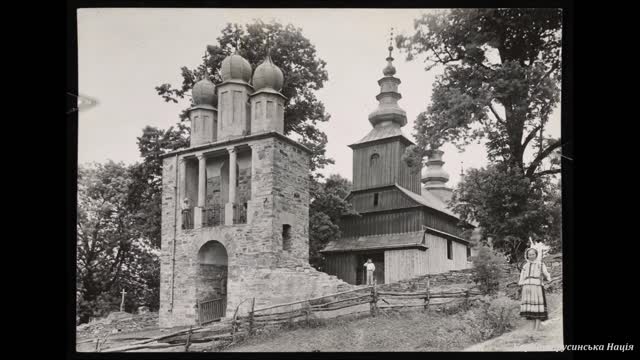Premium Only Content

Lemkos and Lemkovyna №1 | Лемкы і Лемковина
Лемкы і Лемковина
[eng] Lemkos and Lemkivshchyna №1
[pol] Łemkowie i Łemkowszczyzna №1
[ukr] Лемки та Лемківщина №1
[sk] Lemkovia a Lemkivshchyna №1
Lemkos (Rusyn: Лeмкы, Polish: Łemkowie; Ukrainian: Лемки; Slovak: Lemkovia) — are an ethnographic group of Carpatho-Rusyns, living in or originating from the Lemko Region.
The name «Lemkos» is derived from the word «lem», which they often use in conversation, which means «only» and this term appeared only at the beginning of the 19th century; the Lemkos themselves (as well as other ethnographic groups of Carpatho-Rusyns) historically called themselves Rusyns or Rusnaks. By the interwar period the popularity of "Lemko" as an endonym had grown, and appeared in periodicals such as "Lemko" and "Naš Lemko".
Polish authorities also played a hand in popular adoption of the term «Lemkos» as a distinctive ethnographic group and of their corresponding ethnonym. In the aftermath of WWII, Lemko finally supplanted «Rusyn» and «Rusnak» as the term of choice for the Carpatho-Rusyns on the north face of the Carpathians in Poland.
HISTORY: Several hypotheses account for the origin of the Lemkos, however, like all Carpatho-Rusyns, they most probably have a diverse ethnogenetic origin. The Lemkos (and other Carpatho-Rusyns) are considered to be descendants of the medieval White Croats, affected by the migration of Rusyn-influenced Slovaks, and the Vlach/Romanian migrations in the 14th and 15th centuries.
It is estimated that about 130,000 to 140,000 Lemkos were living in the Polish part of the Lemko Region in 1939. Depopulation of these lands occurred during the forced resettlement, initially to the Soviet Union (about 90,000 people) and later to Poland's newly acquired western lands (about 35,000) in the Operation Vistula campaign of the late 1940s. This action was a state ordered removal of the civilian population, in a counter-insurgency operation to remove potential support for guerrilla war being waged by the Ukrainian Insurgent Army (UPA) in south-eastern Poland.
Some 5,000 Lemko families returned to their home regions in Poland between 1957 and 1958, (they were officially granted the right to return in 1956), the Lemko population in the Polish section of Lemkivschyna only numbers around 10,000–15,000 today. Some 50,000 Lemkos live in the western and northern parts of Poland, where they were sent to populate former German villages in areas ceded to Poland. Among those, 5,863 people identified themselves as Lemko in the 2002 census. However, 60,000 ethnic Lemkos may reside in Poland today. Within the Lemko Region, Lemkos live in the villages of Łosie, Krynica-Zdrój, Nowica, Zdynia, Gładyszów, Hańczowa, Zyndranowa, Uście Gorlickie, Bartne, Binczarowa and Bielanka. Additional populations can be found in Mokre, Szczawne, Kulaszne, Rzepedź, Turzańsk, Komańcza, Sanok, Nowy Sącz, and Gorlice.
RELIGION: An important aspect of Lemko culture is their deep commitment to Byzantine Christianity which was introduced to the Eastern Slavs from Byzantium via Moravia through the efforts of Saints Cyril and Methodius in the 9th century. Originally the Lemkos adhered to Orthodoxy, but in order to avoid latinization, directly entered into Union of Brest with the Roman Catholic Church in the 17th century.
Most Lemkos today are Eastern rite or Byzantine-rite Catholics. In Poland they belong to the Ukrainian Greek Catholic Church with a Roman Catholic minority, or to the Ruthenian Catholic Church. A substantial number belong to the Eastern Orthodox Church. Through the efforts of the martyred priest Father Maxim Sandovich (canonized by the Polish Orthodox Church in the 1990s), in the early 20th century, Eastern Orthodoxy was reintroduced to many Lemko areas which had accepted the Union of Brest centuries before.
~~~~~~~~~~~
$ Patreon 👉 https://www.patreon.com/Karpatorusinska_NatsIya
✔ YouTube 👉 https://www.youtube.com/channel/UCFdvYsqnJxkRepKz9Wo22LA?view_as=subscriber
✔ Instagram 👉 https://www.instagram.com/karpatorusinska_natsiia/
✔ Facebook 👉 https://www.facebook.com/Карпаторусинська-Нація-570240669775465
~~~~~~~~~~~
Keywords: Carpatho-Ruthenia Rusnaks Carpatho-Rusyns Карпатські Русины Руснакы Закарпатці Kárpátalja Καρπαθιο-Ρουθήνων Transcarpatia Zakarpattia Oblast Transcarpathian Zakarpattia Rusyns Carpathian Ruthenia rusníacos Русини Podkarpatská Rus Русины Закарпаття Закарпатья Rusíni rusinos Zakarpacie Cárpatos Закарпатська область Βερχόβιντσι Subcarpathian קרפטו-רותנים רוסינים რუსინები روسينيون 喀尔巴阡-罗斯 ڕووسین 人 ルシン人 卢森尼亚人 喀尔巴阡-卢森尼亚人 루신인 Ռուսինները روسینها روسناکها کوههای کارپات Người Rusyn người Karpat-Rusyn Rusīni Lemken Russinen verchovyniečiai Rusinen dolnianai Ruthenen Rusinler Βοϊκο Русіны Karpatų rusinai Rusinlər Ρουθήνιοι carpatorrutenos Λέμκο sotakai Rusinai cárpato-rutenos Rusniaken russinos Ορεσίβιοι Russynen Karpatijas rutēņi Rusynes copakai Rusinos Karpaten rusniacos Karpatorussen carpatorrutenos Karpatenrussinen subcarpática Rutenoj ruteno Huculoj carpato-ruthène Verchovincoj boikai Bojkoj Lemkoj lemkai Karpatoj Rusyns
-
 14:41
14:41
Scammer Payback
15 days agoScaring Fake Amazon Scammers
55.5K54 -
 2:28:10
2:28:10
Game On!
15 hours ago $11.89 earnedNFL Turkey Day Deep Dive! Wise Guy Round Table and Best Bets!
67K6 -
 2:46:25
2:46:25
Fresh and Fit
17 hours agoConor McGregor Accused Of Assault!
254K139 -
 3:42:32
3:42:32
Alex Zedra
15 hours agoLIVE! Chill stream before Thanksgiving!
180K27 -
 5:00:01
5:00:01
Pepkilla
17 hours agoDouble XP Zombies and Warzone ~
70.7K10 -
 0:46
0:46
Dr Disrespect
2 days agoIt's not just a stream... it's an experience
598K2.95K -
 1:28:27
1:28:27
Kim Iversen
1 day agoBOMBSHELL: Secret British Military Plot to Prolong the Ukraine War And Take Down The Grayzone
163K285 -
 11:54
11:54
Professor Nez
16 hours ago🚨CHILLING REVELATION: Tucker Carlson Reveals Dems NEXT PLAN to STOP Trump!
173K92 -
 6:51
6:51
Colion Noir
15 hours agoI have Something To Say To Gun Owners
110K29 -
 1:18:24
1:18:24
Glenn Greenwald
20 hours agoLiberals Encourage Family & Friends To Separate Over Political Disputes; Segment Debut Of System Pupdate: Profiles Of Rescued Dogs | SYSTEM UPDATE #373
164K457